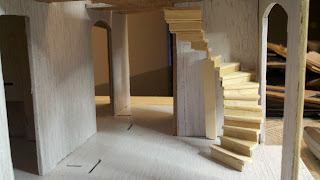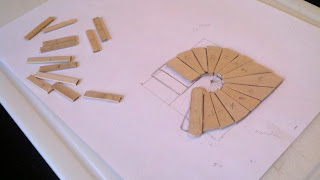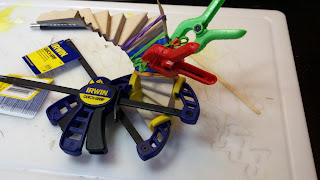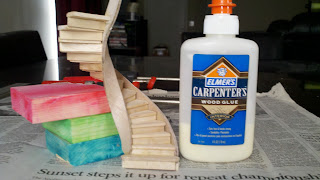 |
| Real-life inspiration for my mini-version |
The Fairfield does not have a lot of floorspace to convert to stairs. But it demanded a lovely, grand, eye-catching spiral staircase. Here's how I did it.
Admittedly, I could have done this a lot more simply than I did. Hindsight is better than foresight, and now I know there are calculators on the internet that help one figure out rise, run and angle (like this one), and even give you a nice pattern to print out, but me being me, I sort of just winged that part. I'm pretty proud of how it all turned out, especially because math and geometry are really not my strong suit!
First, there's one important distinction about my method. While the difference between a spiral and curved staircase may not seem like much, there is in fact a difference: a spiral staircase rises radially around a central support and a curved and/or circular staircase does not have a central support and can adopt varying degrees of curvature, allowing for changes in direction based on the particular design situation. It's not terribly important, but if you need to google for specific information (like inspiration photos) separating the terminology can help.
Secondly, there are some terms to keep in mind, such as the tread (the flat piece of wood you stand on) the riser (the vertical support for the tread) and the stringer (the supporting piece of wood on outside of the tread/riser.) In my case, the curved stairs are free-standing or floating (not supported from underneath) and the stringer (actually called a closed stringer because the treads are not visible) serves as the single point of support for the entire stairway, aside from where it mounts to ceiling and floor. Even though this is in miniature, the strength the stringer adds to the staircase is really helpful.
This is the dry fit before I began assembling the stringers. If you're familiar with the Fairfield layout, this view looks through the back of the regular "kitchen" toward the front door, and previously the straight staircase was located on the large wall section to the left. If you're not familiar, then you're seeing a sneak peak at my large entry hall. The space for this new curved stair is very small and measures a mere 3". I wanted a 3 ft (or 1.5") wide staircase, so this space just happens to suit my idea perfectly.
To give this small space a "grander" flair, I changed the angle of the curve slightly so that the bottom half of the staircase flairs out into room a bit and the bottom tread is slightly larger, which creates a more formal look. Additionally, the staircase rises directly in front of the bay window, adding a dramatic wash of light. I was hesitant to block the window at first, but the more I thought about it, the more I decided it would create another romantic effect - a lovely little reading alcove.
My first step was to draw my stair design. I already knew the basic size needed to be confined to 3 inches along the back wall, and I wanted the stair to really fit in that space without blocking the hall or access to the bay window. So I drew a 3 x 3 box. Then, knowing that my stairs were going to be a max of 1.5" wide, I found the center of the box and marked it.
Finally, I needed to do some basic math to figure out how many stairs I needed and the angle. I already knew I wanted my total rise (actual riser height + tread height) at 8 inches (I knew this because I measured some stairs in my house...very scientific, I know) which translates to about 8 mm. I also knew the ceiling height was 5" or 10 ft. So, I did a basic calculation:
10 x 12 = 120 inches (converting feet to inches)
120 (height)/8 (total rise) = 15 (# of stairs)
So, I knew that I needed to cut 15 stair treads that were about 1.5 mm thick (or 1.5 inches in 1:24 scale - see the converter here) I then marked the 1/2" tread in increments along the outside of the box, and began drawing lines from the center dot to the outside mark. Ideally, you want every tread to align to the same angle - in my case, I'm pretty close to a 220 degree angle. Again, not as scientific as it could be. In the picture above, I drew a copy of the first design - one as a pattern to cut, and one to use as a layout guide. If I had gone with the calculator method in the link above, it would have created a pattern I could print and that would have simplified this entire process immensely.
Here I have cut the treads and riser pieces (out of 1/16th basswood) and marked them to keep the order.
Next, assembly. This was probably the trickiest part, because I had to be able to support the stair while the glue dries. Luckily I had a lot of 1/2" scrapwood, but anything that can support the stair's weight so that the tread/riser combo dries straight will work.
Here I'm taking the completed stair and attaching the stringers. These are 1/32 birch plywood (veneer thickness) that I cut on a diagonal and softened inside of wet paper towels that I heated in the microwave. I don't have a picture of the cuts I made, but it's essentially cutting on the bias - diagonally across the straight grain of the wood. This gives it a lot of flexibility it doesn't have which is absolutely necessary for bending it to this tight of a curve. Then I lathered them with glue and carefully bent them around the curves on the stair. I used rubber bands and clamps to keep them properly aligned.
I layered 4 stringers together on each side to give the stringer a thickness of 3" in 1:24 scale. This is just wide enough to support the railing and balusters that I'll install later, and doesn't look bulky.
Here's the finished assembled staircase with wood gaps filled (shown here on the second floor.) My next steps, which I'll detail in a second post, are to sand everything smooth,"bullnose" the treads, apply the floating back for a solid look, assemble the railing and paint!

















1 comments:
I love staircases! And your is gooorgeous! Well done, indeed!
Post a Comment